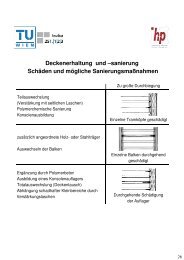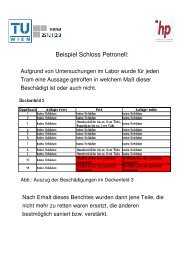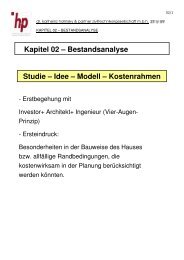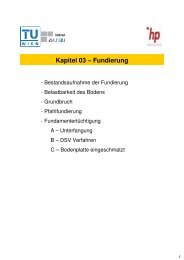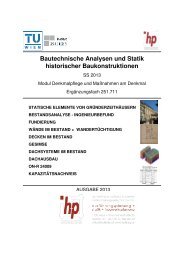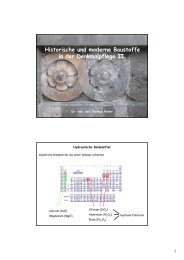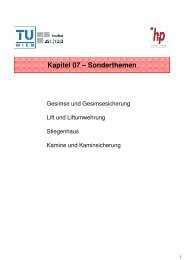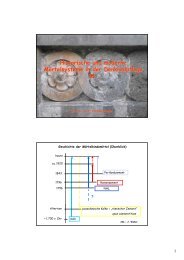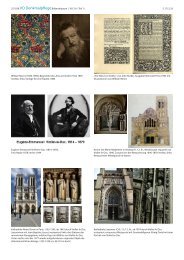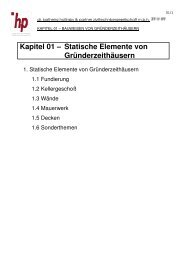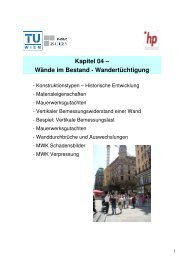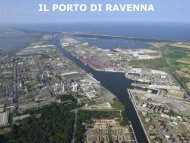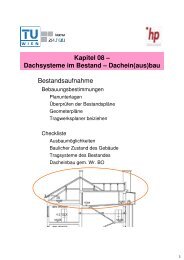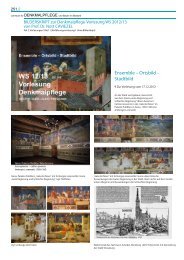Industrial monument preservation in Austria- A survey - Denkmalpflege
Industrial monument preservation in Austria- A survey - Denkmalpflege
Industrial monument preservation in Austria- A survey - Denkmalpflege
Create successful ePaper yourself
Turn your PDF publications into a flip-book with our unique Google optimized e-Paper software.
The oil crisis of 1973 that brought the western hemisphere to a standstill and demonstrated the<br />
vulnerability of a globally networked economy also produced the idea of “limits to growth”.<br />
Academic <strong>in</strong>volvement with the phenomena of <strong>in</strong>dustrial history and <strong>in</strong>dustrial sociology became a<br />
focal po<strong>in</strong>t of a new student generation; social history <strong>in</strong> the form of “grass-roots history” addressed<br />
the <strong>in</strong>dustrial work<strong>in</strong>g class threatened with ext<strong>in</strong>ction, while economic history aimed at<br />
disentangl<strong>in</strong>g the world-wide network of <strong>in</strong>dustrial capitalism, the history of technology attempted<br />
to come to terms with the rapid scientific and technical progress of <strong>in</strong>dustrial production, and<br />
environmental history hoped to expla<strong>in</strong> the global changes to our biosphere through<br />
<strong>in</strong>dustrialisation as a consequence of human life and bus<strong>in</strong>ess activity.<br />
Without doubt the most decisive impulse for a new beg<strong>in</strong>n<strong>in</strong>g was given to <strong>in</strong>dustrial <strong>monument</strong><br />
<strong>preservation</strong> <strong>in</strong> <strong>Austria</strong> as a result of the establishment of <strong>in</strong>dustrial archaeology, whose aim was the<br />
systematic research of the <strong>in</strong>dustrial heritage. The specialist world’s attention was caught by the<br />
First International Congress on the Preservation of <strong>Industrial</strong> Monuments held <strong>in</strong> Ironbridge <strong>in</strong><br />
1973, an event that spread the fame of <strong>in</strong>dustrial archaeology far beyond the borders of Great<br />
Brita<strong>in</strong>.<br />
The very conference venue, the Coalbrookdale Museum of Iron, was an <strong>in</strong>citement to imitation. The<br />
euphoria that overcame the specialist world follow<strong>in</strong>g the Ironbridge Congress also produced a<br />
wave of museum foundations. The aim of all these <strong>in</strong>stitutions was to preserve historical production<br />
centres <strong>in</strong> situ, where the visitors would be confronted with the world of work of the <strong>in</strong>dustrial age.<br />
In <strong>Austria</strong>, the <strong>in</strong>stitutions and display m<strong>in</strong>es already established were jo<strong>in</strong>ed by a number of<br />
museums of this new type. Examples are the M<strong>in</strong><strong>in</strong>g Museum and Display M<strong>in</strong>e founded <strong>in</strong><br />
Hüttenberg / Car<strong>in</strong>thia <strong>in</strong> 1978, the Petroleum Museum opened <strong>in</strong> Neusiedl an der Zaya / Lower<br />
<strong>Austria</strong> <strong>in</strong> 1980 and the Coal M<strong>in</strong><strong>in</strong>g Museum <strong>in</strong>augurated <strong>in</strong> Fohnsdorf / Styria <strong>in</strong> 1983. The north<br />
of the country was dom<strong>in</strong>ated by textile production, as witnessed by the numerous weav<strong>in</strong>g works<br />
and dye works converted <strong>in</strong>to small museums, brought together for visitors <strong>in</strong> the form of tourist<br />
routes such as the Textile Road <strong>in</strong> Lower <strong>Austria</strong> and the so called Weav<strong>in</strong>g Road <strong>in</strong> Upper <strong>Austria</strong>.<br />
The variety of <strong>in</strong>stitutions of this k<strong>in</strong>d, comb<strong>in</strong>ed with all k<strong>in</strong>ds of services for tourists, have<br />
become <strong>in</strong>creas<strong>in</strong>gly popular over the years, with the result that <strong>in</strong>dustrial tourism was able to<br />
develop <strong>in</strong>to an admittedly small but <strong>in</strong>deed attractive and prosperous segment of the tourist<br />
<strong>in</strong>dustry.<br />
The <strong>in</strong>tensive discussion of <strong>in</strong>dustrial culture was also reflected <strong>in</strong> the topics of numerous prov<strong>in</strong>cial<br />
exhibitions. Their objectives were regarded as be<strong>in</strong>g the fields of cultural and educational policies,<br />
but they were also based on aspects of <strong>monument</strong> <strong>preservation</strong> or scientific research, and always<br />
pursued the promotion of tourism and the regional economy. The topics of “m<strong>in</strong><strong>in</strong>g” or “the<br />
<strong>in</strong>dustrial world of work” became extremely popular amongst the public, reward<strong>in</strong>g the organisers<br />
with record visitor numbers time after time.<br />
In Steyr / Upper <strong>Austria</strong>, the “Work/man/mach<strong>in</strong>e” Prov<strong>in</strong>cial Exhibition hit cultural policy<br />
headl<strong>in</strong>es <strong>in</strong> 1987 by attract<strong>in</strong>g over 380,000 visitors. Its topic was the history of the <strong>in</strong>dustrial<br />
world of work, the venue a disused factory on the Wehrgraben, the former ma<strong>in</strong> artery of <strong>in</strong>dustry<br />
<strong>in</strong> Steyr. When the enterprise went bankrupt <strong>in</strong> 1981, the site ceased to function as a production<br />
Institut für Kunstgeschichte, Bauforschung und <strong>Denkmalpflege</strong> | Lehrstuhl für <strong>Denkmalpflege</strong> und Bauen im Bestand<br />
Seite 4 | 7



